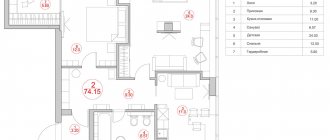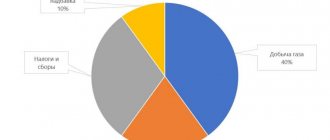Surely you don’t like to overpay, especially if you know that the costs could have been avoided. A good example is gas prices. If pricing is based on the rate of gas consumption per person per month, then in fact the client will pay for others or for the volume that he did not consume. Agree, you don’t mind mastering this aspect in order to first help yourself, and then give advice to others.
There are no big difficulties or secrets in calculating the price of blue fuel. At the same time, legal nuances can greatly “mix the cards” for an ordinary consumer. He may be left without a discount or misestimate the benefits. Find out what the gas tariff consists of, what consumption standards are currently in effect and what to do to pay less.
Gas cost calculation
For economic feasibility, blue fuel is supplied with centralized distribution of gas supply networks. The final tariff for the energy resource is determined based on the price approved for the region and the volume of gas consumed previously.
The cost of fuel includes the costs of production and transportation of the energy carrier. It will also include the costs of materials and the construction of gas pipelines for fuel extraction and distribution. Consumers have to cover taxes and the amount spent on industry security.
As can be seen in the picture, gas supply, as well as gas-dependent heating and hot water supply, accounted for 60% of the utility payment structure. As of 2021, the situation has not changed significantly
Regional government structures have the right to introduce their own coefficients for pricing, but only according to the methodology generally accepted throughout the country. From year to year, tariffs are indexed taking into account the level of inflation. Prices are brought into line with the economic situation and, at the same time, correlate them with the cost of living.
For low-income and vulnerable citizens, as well as for large families, orphans, pensioners, rural doctors and teachers, labor veterans, military personnel and their families, Russian legislation has provided benefits for the installation of meters and special tariffs. The decision to include certain population groups in the preferential category is made by regional authorities.
At the federal level, there are discounts for holders of the highest state awards, disabled people, families with disabled children, juvenile prisoners of concentration camps, and families of deceased military personnel.
Local energy and tariff departments will give a discount on gas if the following points are met:
- the consumer has presented documents confirming membership in a particular category;
- there is no debt for utilities;
- the subscriber paid for gas no later than the 10th.
Local authorities set retail prices.
For each residential premises there is a limit of 8.1 m³ of gas per month, which is subject to preferential consumption. With a missing gas heater, the norm will be 5.3 m³. For a room with a meter and a gas boiler, the limit was set at 12.7 m³. 10.6 preferential cubic meters of gas are allocated for cooking.
Distinction between social categories receiving federal and regional benefits: at a higher level, what matters primarily is merit to the state
Russian Government Decree No. 761 talks about subsidies for consumers of utility services, including gas. The legal act regulates the issue of regional standards of standard area for calculating benefits, local standards for the cost of residential complex services. The document did not ignore the burden on the total income of families: a maximum share of expenses for living quarters and utilities was established.
Benefits of using a gas meter
In order not to depend on gas standards, you will have to install a meter in your apartment/house. The device will benefit primarily those who consume fuel in small quantities.
In the case of gas meters, the following requirements are observed:
- Quality standards for metrological instruments.
- The requirement to purchase equipment in accordance with the parameters of the gas mixture.
- Verification periods and standard service time.
- Rules for creating a personal gas project.
- The requirement to involve a licensed organization in installation and only if it has permits.
After installing a gas metering device, it must be sealed by an employee of the controlling structure. The characteristics of the meter can be found in the product data sheet. Gas meters that are not on the State Register list cannot be put into operation.
The photo shows a gas meter thermal corrector. The device is used in open spaces and in rooms where the temperature is outside the normal range.
The design features of the meter ideally allow the indicators to be adjusted due to changes in temperature conditions. No one will force you to buy just such a device, but if it is not there, then an increasing factor will be applied to the subscriber. The last parameter includes the climatic conditions of the region and differentiation by month.
In Russia, the following general coefficients apply:
- 1.00 - June, July;
- 1.01 - August, May;
- 1.02 - September;
- 1.04 - April;
- 1.06 - October;
- 1.07 - November, March, December;
- 1.09 - January, February.
The price of blue fuel also depends on the amount of gas consumed. The subscriber will pay a much larger amount if he does not invest within the prescribed framework.
The subscriber is also required to report data from the gas meter no later than the 26th of each month. If there is no information during the 1st quarter, the consumer will receive a receipt in which the charges will be equal to the monthly average for the last year
Within the limit, the cost approaches the minimum values. This approach will not be the most pleasant, but still it is better than paying “blindly”. Consumers are required to report monthly meter readings to their gas supplier.
New gas tariffs for Moscow and the Moscow region
The retail price (tariff) for gas is the price of gas sold to the population to satisfy personal needs. Retail prices (tariff) for natural gas are regulated by the state. Retail prices for natural gas are calculated and set in rubles, taking into account the price of value added tax per 1000 m³ or per 1 m³ of gas, adjusted to standard conditions.
If there are gas metering devices, the volume of supplied gas is determined based on the readings of the gas metering device (unit).
If subscribers (individuals) do not have gas meters, the volume of gas consumption is determined in accordance with gas consumption standards. Source
Gas consumption standards without a meter
The volumes of gas consumed depend on the presence/absence of various types of equipment. The level of income of the owners affects to a lesser extent, as does the geographical location - in the northern region the level of consumption may be lower than in the southern.
One way or another, the indicator varies depending on the area. According to the standard gas consumption in a house without a meter, 1 person uses about 10 cubic meters per month.
While Russians are increasingly buying smart meters, legislators have repeatedly proposed fines for the absence of any measuring device
For Muscovites and residents of the region, from July 1, 2021, the standard of 10 m³/person applies. The average resident of the Novosibirsk region consumes the same amount of gas. Slightly more blue fuel is used in Yekaterinburg and the Sverdlovsk region.
In the Krasnodar Territory and Nizhny Novgorod Region, the standard was set at 11 m³/person. per month. Residents of the Samara, Leningrad and Omsk regions consume almost the same amount of gas per person - 13 cubic meters for the same period. The listed standards apply to the population: owners and residents of housing.
Factors influencing gas consumption
The consumption standard is set for six months or a year. The indicator is formed based on only 5 criteria:
- the subscriber lives in a residential building with central heating, centralized hot water supply (DHW), gas stove;
- the consumer uses gas stoves, central heating, but does not have centralized hot water supply;
- there is no centralized hot water supply and gas stove, but a gas water heater (boiler) works;
- the subscriber has a gas stove and water heating device;
- The norm for heating is 1 m² per month.
During the year, everyone registered in an apartment or house is charged an amount for gas for cooking and heating water.
During the heating season, which usually falls on October - April, calculations are also made per 1 m² of heated area.
The image shows the installation of central heating and centralized hot water supply: thanks to a gas or electric water heater, you can do without these utilities
The following areas of gas consumption are distinguished:
- the consumer cooks food and heats water on a gas stove;
- the subscriber heats the water using a water heater;
- residents use a boiler at the same time as there is no centralized hot water supply, and also heat water and cook food on a gas stove;
- the consumer uses gas for heating and other purposes (except for those specified in the next paragraph);
- the client heats and/or generates energy using all types of boilers and/or other equipment that is in common ownership of the owners of residential premises in multi-apartment buildings.
The latter option includes 3 levels of fuel consumption: up to 10 thousand m³/year, from 10 to 100 thousand m³/year and over 100 thousand m³/year.
Tariff calculation for the population
The minimum acceptable cost limits were determined in the appendix to Government Resolution No. 373. They relate precisely to the subscriber’s belonging to any territory.
When drawing up these regional standards, local characteristics were taken into account. For one cubic meter of gas, Russian residents pay from 5 to 9 rubles.
The population pays for the costs at each stage of gas supply, from production and transportation to the payment of the gas distribution organization, and the consumer also pays taxes on mineral extraction and industry development
The amount of payment is set taking into account the area of heated space for residential and non-residential purposes. The number of registered and temporary residents and the level of amenities are also important.
The indicators will ultimately indicate the norm for 1 person per month and the cost of fuel consumed during this period. Customers have the right to demand a recalculation of the total cost of gas if the number of residents actually differed from the data used.
Owners of agricultural buildings pay for gas, which is used for raising livestock. One horse consumes an average of 5.2-5.3 m³ per month, a cow - 11.4-11.5 m³, a pig - almost twice as much, 21.8-21.9 m³ per month.
Payment order
Payment for gas usually comes separately from receipts for other resources and housing and communal services. Charges are made based on the current tariff. In the absence of meters, the management company independently sets the price depending on the established consumption standards. Residents only have to pay the specified amount.
This can be done in person at any bank or via the Internet and mobile applications. In this case, gas payments are made using your personal account number. If the payment has not arrived or a debt has arisen for another reason, the specified amount will be credited the next month without any penalties or interest.
Ways to save fuel
The main opportunity to reduce costs is to install a meter. The formula with payment for the volume consumed will be beneficial primarily for the population: gas consumption rates in the case of 90% of apartments will exceed real consumption. Accruals based on standards will lead to increased financial burden.
Tariff features:
- Payment for consumed volume: minimum and increased tariffs apply.
- Payment according to standards: domestic gas use, number of residents and housing area matter.
One of the saving options is to maintain the normal condition of gas equipment. Frequent checks of gas-using appliances will allow timely identification of technical faults, which not only lead to increased gas consumption, but also pose a danger.
If problems arise and the equipment operates with very low power or breaks down, then you need to check the ventilation for the gas appliance, or even better, call a gas technician right away
A non-working boiler will consume at least 1 cubic meter of fuel per day. The heating efficiency of individual rooms is increased thanks to sensors with preset indicators for automatic boiler systems.
Savings can be achieved by simply preventing the penetration of cold air masses, as well as by optimizing the microclimate in a house or apartment. Reliable thermal insulation combined with sealing of window structures and door frames will eliminate heat leakage.
Monitoring temperature conditions will also give results. It is enough just to reduce the heating intensity during periods of absence and monitor the temperature regime, and the money will remain with the consumer.
Standard practice calls for regulating the flow of energy into appliances in individual rooms. In cool rooms, surfaces are insulated with carpets and other heat-insulating coverings.
Insulating the facade of a private house or apartment building will significantly increase the comfort for residents and save up to 25% of the total consumption of blue fuel
Smart consumers also pay attention to the ventilation system. It is known that supply-type ventilation in the kitchen, when the pressure in the room decreases, will intensively supply cold air from the outside.
Even at the stage of purchasing household gas appliances, you should ask about their efficiency and efficiency in terms of energy efficiency. The documentation for devices usually contains such information.
Conclusions and useful video on the topic
Installation of smart devices for metering gas consumption, so-called smart meters - an opinion on the authorities’ initiative:
A legal way to save gas by insulating a gas pipe without incurring significant costs:
To summarize, we note that no matter how many cubic meters of gas there are per person, without a meter there will be fewer options for saving. Depending on the region, cooking and heating water requires from 10 to 13 m³ of gas per person per month. The indicator is adjusted upward based on the gas equipment used.
The estimated consumption per square meter during the heating season is several times lower than the maximum standards per person and one and a half to two times less than the minimum. As for the price per cubic meter, it lies in the range between 5 and 9 rubles per 1 m³ of fuel.
Chat with other readers and ask questions. Perhaps someone will come closer to solving their problem after reading your comment. Be sure to use the form below if you have valuable experience. Tell us how you achieved a positive result in terms of saving gas or recalculating its consumption, and what actions you took to achieve this.
How to make calculations
The cost of gas for the population is calculated using tariffs. In this case, the availability of metering devices plays an important role. In this case, the amount payable will be lower.
By meter
It is especially beneficial to install such devices in those apartments where gas is used only during cooking. When installing the meter, you must take into account a number of rules:
- the type of equipment must comply with the regulations;
- Only gas service specialists can carry out installation;
- a new device is subject to mandatory sealing;
- after the expiration of the permissible period, the device is either checked or replaced with a new one.
How much a cubic meter of gas costs according to the meter is determined by multiplying the consumed cubic meters by the current tariff. The number of cubes is displayed on the counter. His readings are recorded monthly by residents and entered into their bills. From time to time, representatives of the management company can check the data with the values reflected by metering devices. It is prohibited to not allow the inspector into the apartment or to interfere with the performance of his direct duties (Resolution of the Government of the Russian Federation No. 354 of 05/06/2011).
Without him
If there are no metering devices, the amount payable is calculated based on the minimum consumption standards. However, they are disadvantageous because practically residents use less gas, especially if the equipment is required only in the kitchen. The specific cost of how much to pay for gas without a meter is determined by local authorities.







